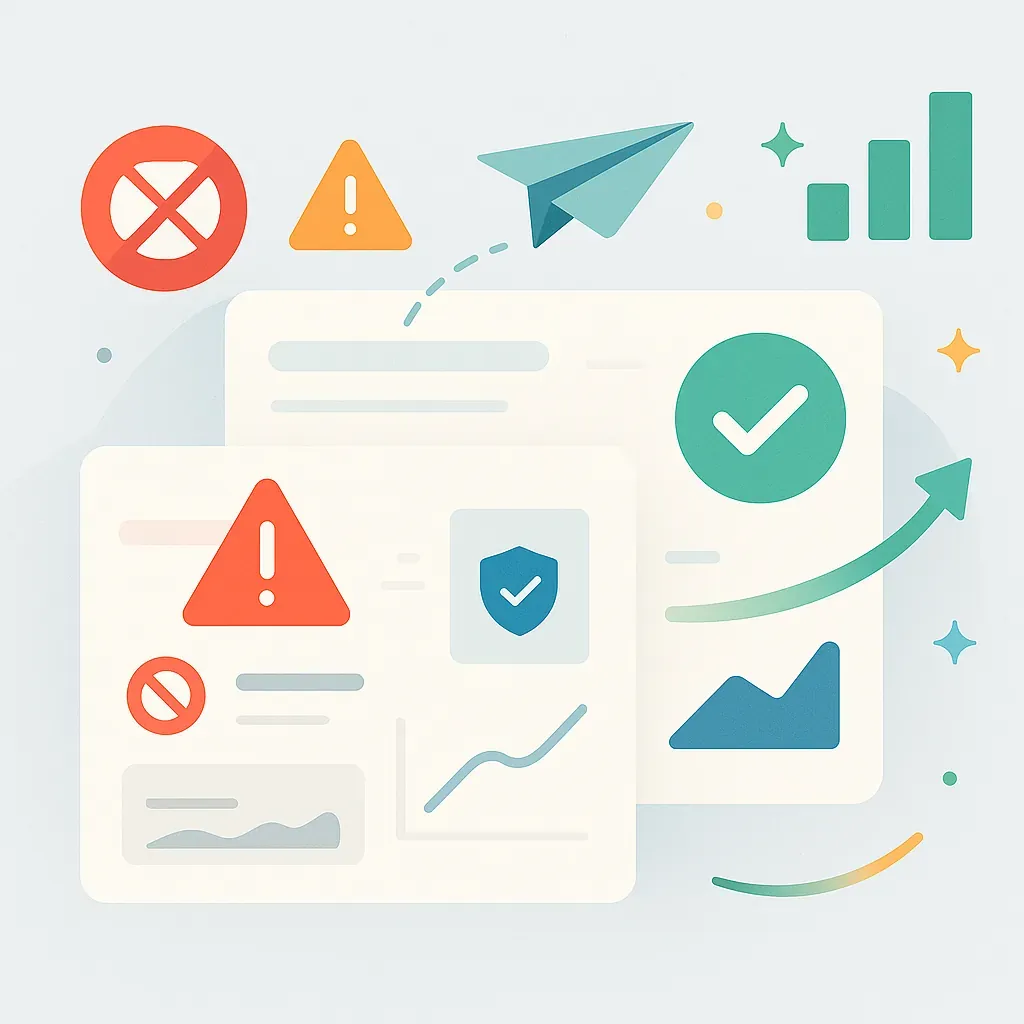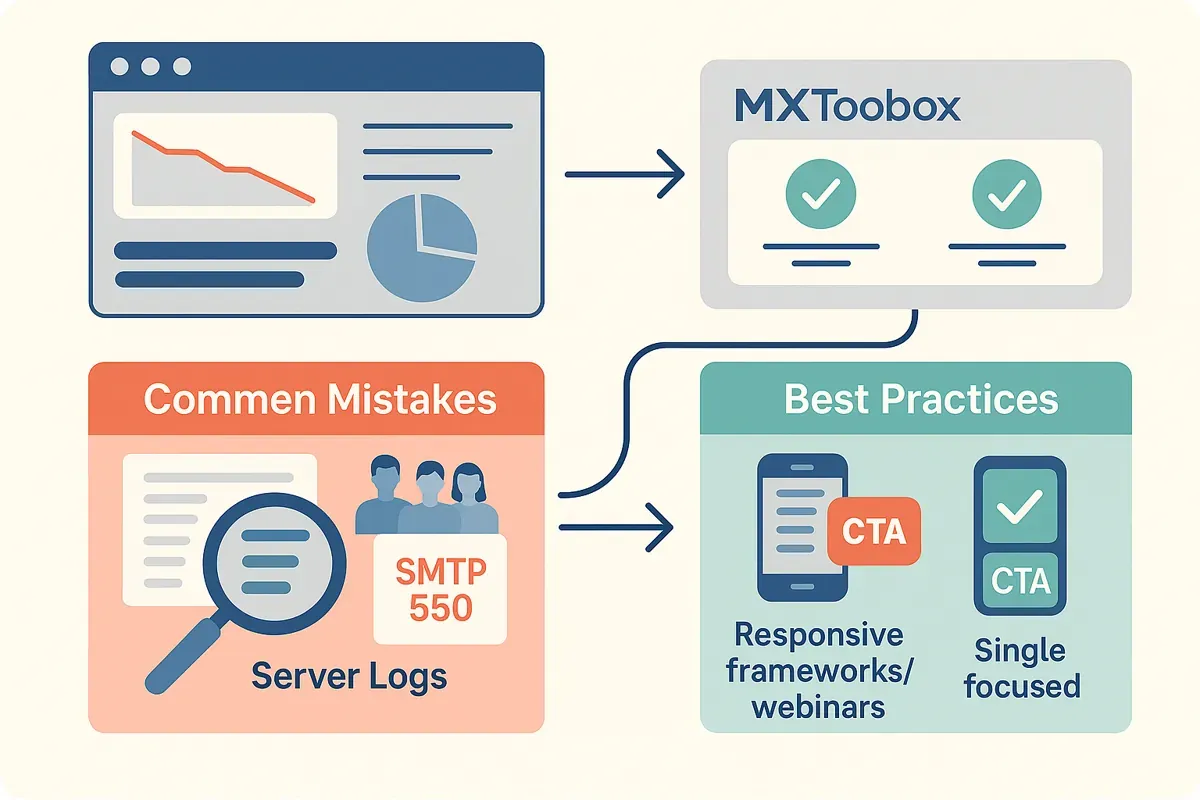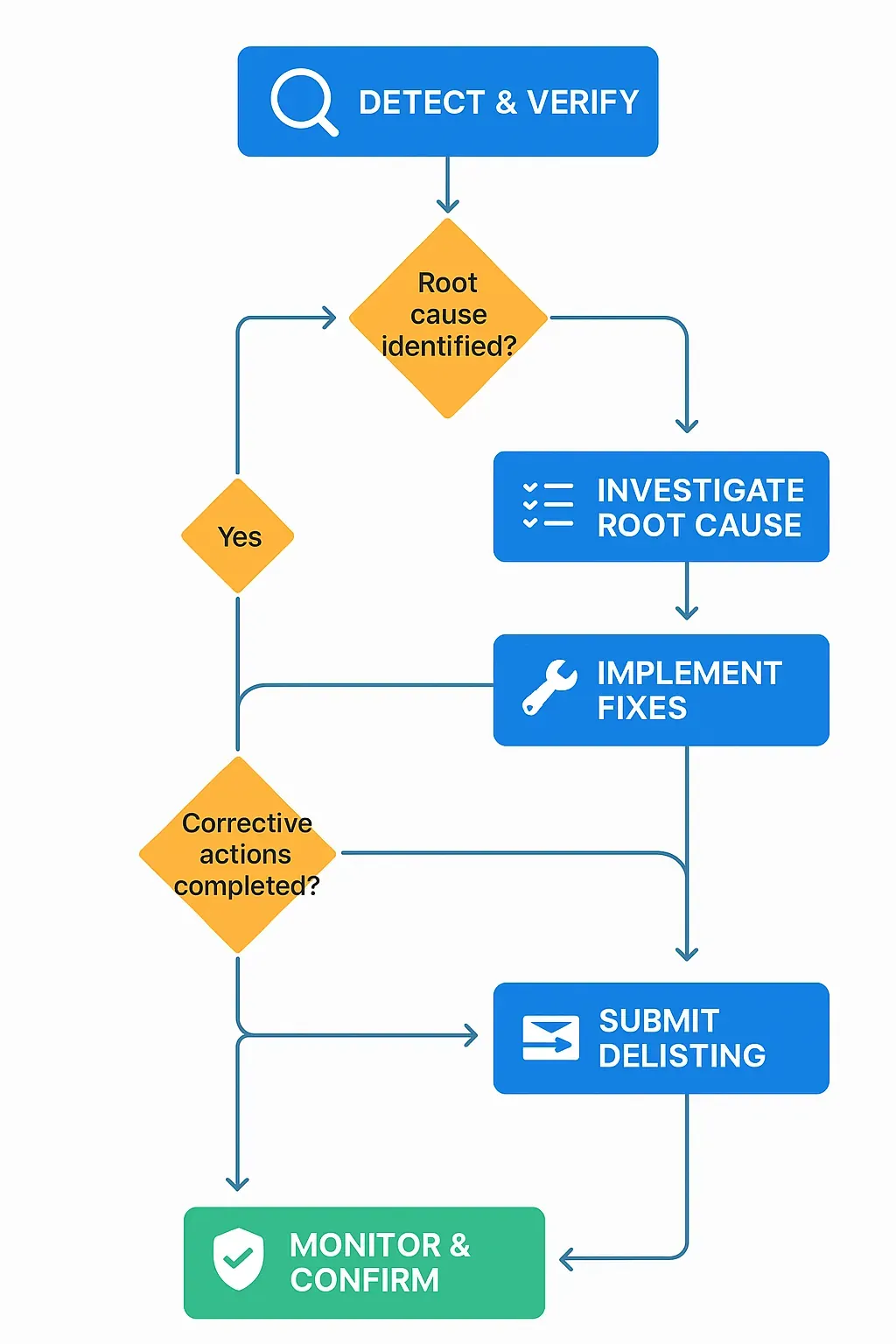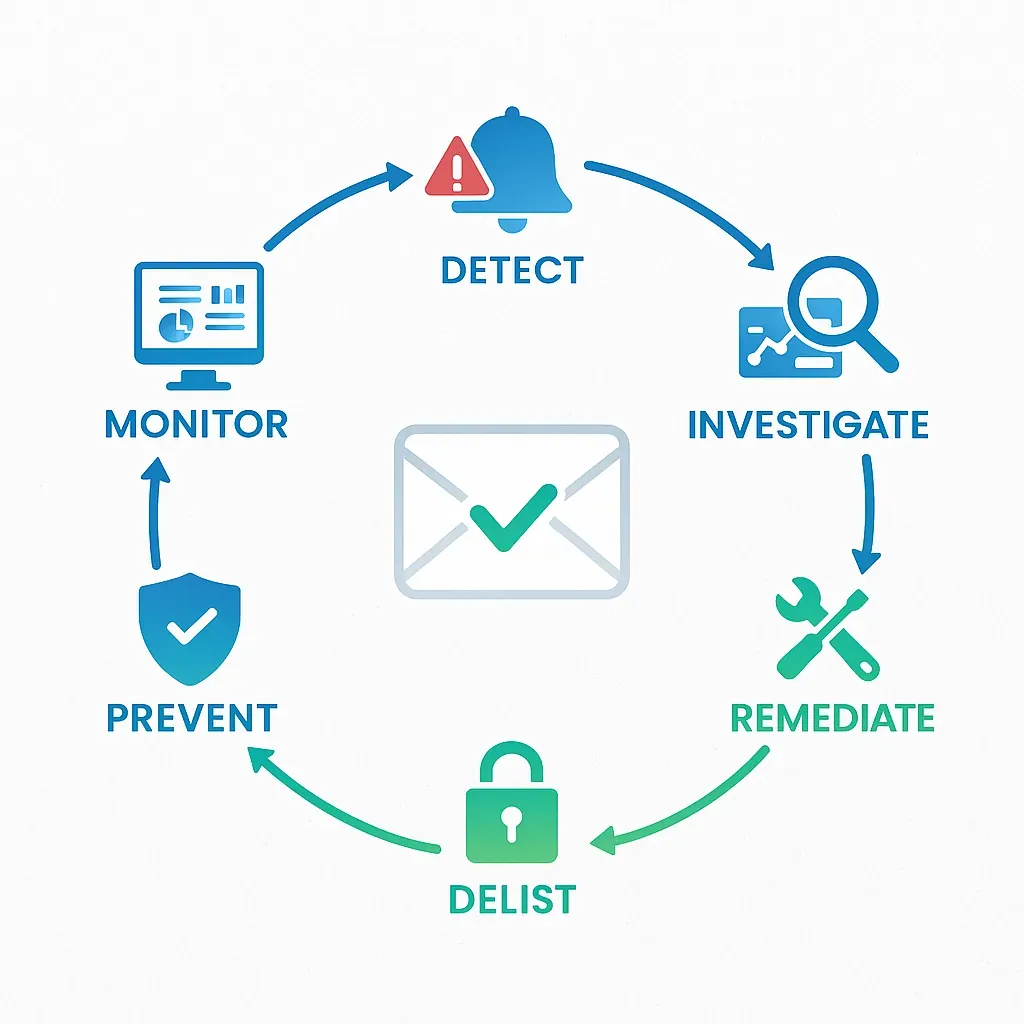Email Blacklist Recovery: Steps to Restore Your Sender Reputation
Master email blacklist recovery with proven strategies. Remove your domain from blocklists, restore sender reputation, and fix deliverability issues fast.

Discovering your emails are being blocked or landing in spam folders due to blacklisting is one of the most frustrating challenges for email marketers. One day your campaigns are reaching inboxes normally, and the next, your open rates plummet to near zero. Your carefully crafted messages never reach their intended recipients, your sender reputation suffers, and your marketing ROI disappears overnight.
Email blacklist recovery isn't just a technical problem—it's a business crisis that demands immediate action. When your domain or IP address lands on a blacklist, major inbox providers like Gmail, Outlook, and Yahoo automatically filter your messages away from recipients. The damage compounds quickly: existing campaigns fail, customer communications get blocked, and rebuilding trust with email service providers becomes increasingly difficult with each passing day.
This guide provides a systematic approach to email blacklist recovery, covering identification, removal procedures, prevention strategies, and long-term reputation management. Whether you're dealing with your first blacklist incident or managing ongoing deliverability challenges, these proven strategies will help you restore your sender reputation and get your emails back into inboxes.
TL;DR - Key Takeaways
- Identify the problem fast: Use blacklist checkers like MXToolbox and check bounce messages to determine which lists have blocked your domain or IP address
- Remove yourself systematically: Follow each blacklist's specific delisting procedure, which typically involves submitting removal requests and demonstrating corrective actions
- Fix the root cause: Address underlying issues like compromised accounts, poor list hygiene, or spam complaints before requesting removal to prevent re-listing
- Monitor continuously: Implement automated monitoring tools to detect future blacklist incidents within hours rather than days
- Prevent recurrence: Maintain authentication protocols (SPF, DKIM, DMARC), practice list hygiene, and gradually warm up new IP addresses
What Is an Email Blacklist?
Quick Answer: An email blacklist is a real-time database of IP addresses and domains identified as sources of spam or malicious email activity. Internet service providers and email security systems query these blacklists to automatically filter or block incoming messages from listed senders. Email blacklist recovery becomes necessary when your sending infrastructure appears on these databases, causing legitimate messages to bounce or land in spam folders instead of reaching recipient inboxes.
Email blacklists serve as protective mechanisms for the email ecosystem. Organizations like Spamhaus, Spamcop, and SORBS maintain these databases by tracking spam complaints, monitoring sending patterns, and identifying compromised servers. When email providers like Gmail, Microsoft Outlook, or corporate mail servers receive incoming messages, they check sender IP addresses and domains against multiple blacklists before deciding whether to deliver, quarantine, or reject the message.
How Blacklists Affect Your Email Delivery:
Blacklist listings create immediate and severe deliverability consequences. Messages from blacklisted senders typically face one of three outcomes: hard bounces with "550" or "554" error codes indicating permanent rejection, soft bounces where receiving servers temporarily defer delivery pending further review, or automatic routing to spam folders without notification to either sender or recipient.
The operational impact extends beyond individual campaigns. Email providers use blacklist data as one factor in calculating sender reputation scores, which influence inbox placement for all future messages. A single blacklisting can damage months of reputation building, affecting deliverability even after successful removal from the blacklist itself.
💡 Critical Insight: Most blacklist incidents stem from preventable issues like purchased email lists, inadequate authentication, or compromised accounts rather than intentional spamming behavior.
Types of Email Blacklists:
Different blacklists target different aspects of email abuse. IP-based blacklists track sending server addresses and affect all email originating from those servers. Domain-based blacklists focus on sender domains and "From" addresses used in email headers. URI blacklists scan message content for malicious links rather than evaluating sender infrastructure. Understanding which type of blacklist has listed you determines your email blacklist recovery approach.
The severity of listings varies significantly. Public blacklists like Spamhaus broadly influence email filtering across many providers and require formal delisting procedures. Private blacklists maintained by individual ISPs affect only their users but may not provide transparent removal processes. Reputation-based systems use blacklist data alongside other metrics, making recovery more nuanced than simple removal from a single list.
How to Identify If You're Blacklisted
Quick Answer: To determine if you're blacklisted, check your domain and sending IP addresses against major blacklist databases using tools like MXToolbox or Spamhaus Blocklist Checker. Review bounce messages from failed emails, which often specify the blacklist causing delivery failures. Monitor your email analytics for sudden drops in delivery rates or spikes in bounce rates, as these indicate potential blacklisting issues affecting your email blacklist recovery efforts.
Email blacklist recovery begins with accurate identification. Blacklisting rarely announces itself with clear warnings—instead, you'll notice symptoms that require investigation.
Primary Detection Methods:
- Bounce Message Analysis: Examine SMTP error codes in bounced emails. Messages containing "550" or "554" error codes with references to specific blacklists (like "listed in zen.spamhaus.org") directly identify which database is blocking you. Configure your email platform to capture and log these detailed bounce messages.
- Blacklist Checker Tools: Run your sending IP addresses and domains through comprehensive checkers. MXToolbox's Blacklist Check scans over 100 DNS-based blacklists simultaneously, providing immediate visibility into your listing status across major providers.
- Deliverability Monitoring: Track key metrics in your email analytics dashboard. A sudden drop in delivery rates below 95%, increased bounce rates above 5%, or declining open rates can signal blacklist issues. Modern platforms like Groupmail provide real-time analytics that help identify deliverability problems before they escalate.
- Inbox Placement Testing: Use seed list testing to verify where your emails land. Services that send test messages to major providers reveal whether your messages reach inboxes, spam folders, or get blocked entirely.
Common Blacklist Categories:
| Blacklist Type | Examples | Impact Level | Typical Cause |
|---|---|---|---|
| IP-based | Spamhaus ZEN, SORBS | High | Compromised server, spam complaints |
| Domain-based | SURBL, URIBL | Medium-High | Malicious links, phishing content |
| Reputation-based | Microsoft SNDS, Gmail Postmaster | Medium | Poor engagement, authentication failures |

Understanding Major Email Blacklists
Quick Answer: Major email blacklists fall into three categories: public blacklists like Spamhaus and SORBS used by most email providers, private blacklists maintained by individual ISPs like Gmail and Microsoft, and URI blacklists that focus on malicious links rather than sender addresses. Understanding which blacklist has blocked you is essential for email blacklist recovery, as each has distinct criteria, removal processes, and impact on deliverability.
Not all blacklists carry equal weight in the email ecosystem. Understanding the major players helps prioritize your email blacklist recovery efforts effectively.
Tier 1 Public Blacklists (Critical Impact):
Spamhaus operates the most influential blacklists in email infrastructure. Their ZEN composite list combines multiple databases and directly influences filtering decisions at major ISPs. Spamhaus listings typically result from spam traps, botnet activity, or significant complaint volumes. Their Spamhaus Block List (SBL) targets professional spammers and verified spam operations, while the Exploits Block List (XBL) identifies compromised systems.
Spamcop employs an automated system that lists IPs based on spam reports from their user network. Listings automatically expire after 24 hours without new reports, making Spamcop responsive to immediate abuse but also prone to false positives from isolated incidents.
Tier 2 Reputation Systems:
Microsoft's Smart Network Data Services (SNDS) and Google's Postmaster Tools don't function as traditional blacklists but maintain reputation scores that affect delivery. Poor performance in these systems results in bulk folder placement or rate limiting rather than outright blocking.
Domain and URI Blacklists:
SURBL and URIBL focus on malicious URLs within message content rather than sender information. These lists protect against phishing and malware distribution. Getting listed here often indicates compromised accounts sending malicious links or legitimate messages inadvertently including flagged domains.
💰 Business Impact: Companies experiencing blacklist incidents report average revenue losses of 23-45% from affected email channels during the listing period, with recovery taking 2-6 weeks on average depending on list severity and response speed.
Regional and Specialized Lists:
Different geographic regions maintain local blacklists with varying influence. UCEPROTECT operates across Europe with automated listing based on spam reports, while Asian markets often reference local databases. Specialized lists target specific abuse types like botnet activity or dictionary attacks.
Key Differences in Listing Criteria:
- Evidence-based lists (Spamhaus SBL): Require verified spam operations or significant abuse evidence
- Complaint-based lists (Spamcop): Automatically list based on user spam reports
- Automated lists (SORBS): Use algorithmic detection of suspicious sending patterns
- Reputation systems (Gmail Postmaster): Aggregate multiple signals including authentication, engagement, and complaint rates
Step-by-Step Email Blacklist Recovery Process
Quick Answer: Email blacklist recovery requires a systematic five-step approach: verify your listing on specific blacklists, identify and eliminate the root cause (compromised accounts, poor practices, or technical issues), implement corrective measures like authentication protocols and list cleaning, submit delisting requests following each blacklist's specific procedures, and confirm successful removal through retesting. Most reputable blacklists process removal requests within 24-48 hours once you've demonstrated corrective action.
Successful email blacklist recovery follows a methodical process. Rushing through steps or skipping root cause analysis often results in re-listing within days or weeks.
Phase 1: Complete Verification and Documentation
Start by documenting your current blacklist status across all major databases. Check both your sending IP addresses and domains:
- Identify All Affected Assets: Test every IP address in your sending infrastructure and all domains used in your email program (sending domain, return-path domain, and any domains in email content).
- Document Listing Details: Record which specific blacklists show your assets, the listing dates, and any reason codes provided. Some blacklists include details about the abuse type or evidence that triggered the listing.
- Review Historical Data: Examine your email sending patterns for the 7-14 days before listing. Look for volume spikes, unusual sending times, increased bounce rates, or complaint rate changes.
Phase 2: Root Cause Investigation
Email blacklist recovery fails without addressing underlying causes. Common culprits include:
Account Security Issues:
- Compromised user accounts sending spam (check authentication logs for suspicious logins)
- Weak passwords allowing unauthorized access (implement two-factor authentication)
- Malware infections on systems with SMTP credentials (run comprehensive security scans)
List Quality Problems:
- Purchased or rented email lists containing spam traps (purge any non-permission-based contacts)
- Outdated contacts with high bounce rates (remove addresses that hard bounced)
- Addresses added without proper consent (implement double opt-in verification)
Technical Configuration Errors:
- Missing or incorrect SPF records allowing spoofing
- Absent DKIM signatures reducing message authenticity
- No DMARC policy enabling brand impersonation
- Shared hosting with other blacklisted senders
Platforms like Groupmail help prevent technical issues through built-in authentication support and integration with reputable SMTP providers like SendGrid and SMTP2GO, which maintain their own reputation management.
Phase 3: Implement Corrective Actions
Before requesting removal, demonstrate you've resolved the problem:
Immediate Actions:
- Pause all email sending from affected IPs/domains
- Reset passwords for all accounts with sending access
- Enable SPF, DKIM, and DMARC authentication (DMARC configuration guide)
- Remove invalid addresses and spam traps from your list
- Implement rate limiting to prevent future volume spikes
Verification Steps:
- Send test emails to seed lists to confirm proper authentication
- Verify DNS records using tools like MXToolbox DNS Check
- Review and tighten access controls for email systems
- Document all changes made for removal request submissions
Phase 4: Submit Delisting Requests
Each blacklist maintains its own removal process. Follow their specific procedures carefully:
Spamhaus Removal: Visit the Spamhaus Blocklist Removal Center and search for your IP or domain. If listed, follow their specific removal process, which may require waiting for automatic expiry on certain lists or providing evidence of corrective action.
Spamcop Delisting: Spamcop listings automatically expire after 24 hours without new reports. Monitor your listing and ensure no new spam triggers re-listing during this period.
Barracuda Removal: Submit requests through the Barracuda Reputation System with detailed information about corrective measures.
Microsoft/Outlook Delisting: Use the Microsoft Sender Support form to request removal from their internal lists.
💡 Pro Tip: When submitting delisting requests, provide specific details about corrective actions rather than generic promises. Blacklist operators respond faster to concrete evidence like "implemented SPF and DKIM, removed 847 invalid addresses, enabled two-factor authentication" versus "fixed the problem."

Phase 5: Confirmation and Monitoring
After submitting removal requests:
- Retest Regularly: Check your status every 4-6 hours using blacklist checkers until removal confirmation appears.
- Resume Sending Gradually: Don't immediately return to full sending volume. Implement a warm-up schedule over 7-14 days to rebuild reputation.
- Monitor for Re-listing: Set up automated monitoring through services like Postmark's Blacklist Monitor to catch any re-listings within hours.
- Track Deliverability Metrics: Watch bounce rates, delivery rates, and inbox placement carefully for 30 days post-recovery to ensure full restoration.
Preventing Future Blacklist Incidents
Quick Answer: Preventing future blacklisting requires maintaining authentication protocols (SPF, DKIM, DMARC), practicing strict list hygiene by removing inactive subscribers and hard bounces, monitoring engagement metrics to identify deliverability issues early, implementing double opt-in confirmation for new subscribers, and using reputable sending infrastructure with established IP reputation. Regular monitoring and proactive reputation management prevent the email blacklist recovery process from becoming necessary.
Prevention proves far more efficient than email blacklist recovery. Implement these strategies to maintain clean sender reputation:
Authentication Best Practices:
Configure and maintain all three major authentication protocols. SPF records specify authorized sending servers for your domain, preventing spoofing. DKIM adds cryptographic signatures verifying message integrity. DMARC policies tell receiving servers how to handle authentication failures while providing visibility into abuse attempts.
Regularly audit these records as your infrastructure changes. Outdated SPF records that exclude current sending IPs create authentication failures that damage reputation.
List Hygiene Standards:
| Practice | Frequency | Impact on Reputation |
|---|---|---|
| Remove hard bounces | Immediately | Critical - prevents spam trap hits |
| Suppress unengaged (180+ days) | Quarterly | High - improves engagement metrics |
| Re-engagement campaigns | Bi-annually | Medium - maintains list quality |
| Double opt-in verification | Every signup | High - ensures permission |
Implement automated list cleaning processes rather than manual reviews. Modern platforms handle this through engagement-based segmentation and automatic suppression rules.
Engagement Monitoring:
Track complaint rates, unsubscribe rates, and engagement trends as leading indicators of potential problems. Complaint rates above 0.1% or declining open rates below your baseline suggest deliverability issues before blacklisting occurs.
Tools like Groupmail's AI subject line generator can help improve engagement rates by optimizing message appeal, while comprehensive analytics identify underperforming campaigns that risk reputation damage.
Gradual IP Warm-up:
When introducing new sending IPs, follow established warm-up schedules:
- Days 1-3: Send to highly engaged segments only (opened last 30 days), maximum 500-1000 emails daily
- Days 4-7: Expand to 60-day engaged subscribers, increase to 5,000-10,000 daily
- Days 8-14: Include 90-day engaged subscribers, scale to 20,000-50,000 daily
- Days 15-30: Gradually approach full sending volume while monitoring metrics
Platforms like Postmark and SendGrid provide detailed guidance on IP warm-up specific to their infrastructure.
Infrastructure Considerations:
Choose between shared and dedicated IP addresses based on sending volume and control needs:
- Shared IPs: Suitable for senders with under 100,000 emails monthly, leveraging provider's established reputation
- Dedicated IPs: Recommended for high-volume senders needing complete control, requires consistent sending to maintain reputation
Using established sending infrastructure through integration platforms provides better starting reputation than hosting your own mail servers. Services like SMTP2GO and SendGrid maintain relationships with ISPs and proactively manage reputation.
💰 Cost Consideration: Implementing proper authentication and monitoring costs minimal time and resources compared to average revenue losses during blacklist incidents, which typically exceed $5,000-$15,000 for small to medium businesses during recovery periods.
Key Terms
Email Blacklist: Database of IP addresses or domains identified as sources of spam or abuse, used by email providers to filter incoming messages automatically.
Sender Reputation: Numerical score assigned by email providers based on authentication, engagement rates, complaint rates, and sending patterns that determines inbox placement.
SPF (Sender Policy Framework): DNS record specifying which mail servers are authorized to send email on behalf of a domain, preventing spoofing and impersonation.
DKIM (DomainKeys Identified Mail): Email authentication method using cryptographic signatures to verify messages weren't altered in transit and originated from authorized senders.
DMARC (Domain-based Message Authentication, Reporting & Conformance): Policy framework using SPF and DKIM to provide domain-level protection and reporting on authentication failures.
Spam Trap: Email address specifically created to catch spammers, appearing on purchased lists or resulting from addresses abandoned for extended periods.
Hard Bounce: Permanent delivery failure due to invalid email addresses, typically indicating the address doesn't exist or the domain is invalid.
IP Warm-up: Gradual process of establishing sender reputation for new IP addresses by slowly increasing email volume over 2-4 weeks.
Delisting: Process of requesting removal from email blacklists after addressing the underlying issues that caused the original listing.
Engagement Metrics: Measurements including open rates, click rates, and time-to-engagement that ISPs use to assess whether recipients want messages from a sender.
Frequently Asked Questions
How long does email blacklist recovery typically take? Email blacklist recovery timelines vary by the specific blacklist and severity of the issue. Most reputable blacklists like Spamcop automatically remove listings within 24-48 hours after abuse stops. Spamhaus typically processes delisting requests within 2-3 business days once you've demonstrated corrective action. However, reputation recovery with major ISPs like Gmail and Outlook may take 2-4 weeks of consistent good sending practices even after blacklist removal, as they maintain internal reputation scores separate from public blacklists.
Can I prevent getting blacklisted while using shared IP addresses? Shared IP addresses can be effectively used while minimizing blacklist risk by choosing reputable email service providers that actively monitor and manage their IP reputation pools. Providers like SendGrid, SMTP2GO, and Postmark implement abuse detection systems that quickly identify and isolate problematic senders before they affect other users sharing the same IPs. However, you retain less control compared to dedicated IPs, so implementing strong authentication, maintaining list hygiene, and monitoring engagement metrics becomes even more critical when using shared infrastructure.
What should I do if I'm blacklisted but can't identify the cause? If the root cause remains unclear after reviewing sending patterns and bounce messages, conduct a systematic audit: check all user accounts for compromised credentials by reviewing authentication logs, scan systems with SMTP access for malware, verify your DNS records for authentication protocols are properly configured, and examine your subscriber list for potential spam traps (addresses with no engagement history or suspicious patterns). Consider temporarily pausing all sends and engaging an email deliverability consultant who can analyze your infrastructure, content, and sending practices to identify overlooked issues.
Do all blacklists require manual removal requests? Not all blacklists require manual removal requests. Some like Spamcop use time-based automatic delisting where listings expire after 24 hours without new spam reports. Others like SORBS may require waiting periods or demonstrated corrective action before automatic removal occurs. Major lists like Spamhaus often require manual delisting requests but may automatically remove listings after extended periods of no abuse for less severe infractions. Always check the specific blacklist's website for their removal procedures rather than assuming manual requests are necessary.
How do I know if deliverability issues are from blacklisting or something else? Distinguish blacklisting from other deliverability issues by examining specific symptoms: blacklisting typically causes sudden, dramatic drops in delivery rates with bounce messages specifically mentioning blacklist databases. Other issues like poor engagement, missing authentication, or spam complaints cause gradual reputation decline with messages reaching spam folders rather than bouncing entirely. Check your domain and IPs against major blacklist databases using MXToolbox—if you're not listed but still experiencing deliverability problems, investigate authentication configuration, sender reputation scores, content quality, and engagement metrics instead.
Is it worth trying to recover from major blacklists like Spamhaus, or should I just get a new IP?
Email blacklist recovery from reputable lists like Spamhaus is almost always worth attempting before acquiring new infrastructure. These blacklists operate fairly and provide clear removal processes once you've addressed root causes. Simply switching IPs without fixing underlying problems results in re-listing of the new addresses, often faster than the originals. Additionally, abandoning listed IPs wastes established sender history and requires complete reputation building from scratch. Only consider new IPs if you've inherited a severely damaged reputation from previous owners of shared infrastructure or if the listed IP has extensive blacklist history across dozens of databases indicating fundamentally compromised infrastructure.
Can using a service like Groupmail prevent blacklist issues? Using email marketing platforms like Groupmail that integrate with reputable SMTP providers helps prevent blacklist issues through several mechanisms: they enforce authentication protocols automatically, provide built-in tools for list management and suppression, offer engagement analytics for identifying problems early, and route your email through established infrastructure with existing positive reputation. However, no platform completely prevents blacklisting if you engage in poor practices like purchasing lists, sending without permission, or neglecting list hygiene. The platform provides tools and infrastructure, but maintaining sender reputation requires following email marketing best practices consistently.
What happens to my sender reputation after successful blacklist removal? After successful removal from blacklists, your sender reputation doesn't instantly return to pre-incident levels. Major ISPs like Gmail, Microsoft, and Yahoo maintain internal reputation scores that factor in blacklist history alongside current sending behavior. Expect a recovery period of 2-6 weeks where you should gradually increase sending volume, maintain excellent engagement rates, keep complaint rates below 0.1%, and demonstrate consistent authentication. During this time, some emails may still reach spam folders as ISPs rebuild trust in your sending patterns. Monitor inbox placement through seed list testing and adjust your approach based on these results rather than just delivery rates.
Restore Your Email Deliverability Today
Email blacklist recovery demands systematic action: identify which blacklists have affected your sending, eliminate the root causes that triggered listing, implement proper authentication and list hygiene practices, submit delisting requests with evidence of corrective measures, and establish monitoring to prevent future incidents.
The most critical factor in successful recovery is addressing underlying issues before requesting removal. Blacklists exist to protect email recipients from abuse—demonstrating genuine corrective action rather than simply asking for removal proves you're committed to legitimate email practices.
Beyond recovery, prevention through authentication protocols, engagement monitoring, and list quality maintenance keeps your sender reputation strong. Regular monitoring catches potential problems before they escalate to blacklist incidents, while proper infrastructure choices provide reputation advantages from established sending history.
Ready to implement robust email deliverability practices? Start with Groupmail's free account—no credit card required. Access unlimited sending through reputable SMTP integrations, comprehensive analytics for monitoring engagement, and authentication support that helps maintain clean sender reputation. Build email campaigns with confidence knowing your infrastructure supports deliverability from the start.





